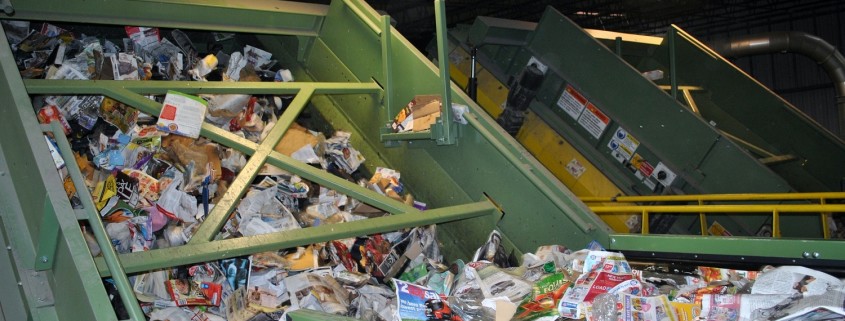Study examines flow of packaging at MRFs
| By Editorial Staff, Resource RecyclingJuly 14, 2015
Just because a wide array of packaging makes it into a curbside cart or bin doesn’t mean it’ll make it into a bale. Up-to-date sortation equipment, as well as recycling-friendly product design and consumer best practices, can help improve the chances, a study finds. The MRF Material Flow Study, conducted by Ann Arbor, Mich.-based Resource Recycling Systems (RRS), suggests materials recovery facilities (MRFs) today lose anywhere from 3 to 12 percent of incoming plastic packaging to the paper stream. Some products increasingly accepted in curbside programs are particularly hard to detect and sort, the study points out, with the average “loss rate” at 29 percent for plastic clamshells and 18 percent for cartons. “For the MRFs that receive the material, it is not always easy to keep sorting technologies and techniques on pace with this expanding mix,” the report states. The study was funded by the American Chemistry Council, the Association of Postconsumer Plastic Recyclers, the Carton Council, the Foodservice Packaging Institute and the National Association for PET Container Resources. It was prepared with the help of Reclay StewardEdge and Moore Recycling Associates. To complete the study, a variety of food-service packaging products, including containers, cartons and cups, were “seeded” into the incoming streams of five U.S. MRFs. The MRFs, four single-stream facilities and one dual-stream facility ranging in throughput from 10 to 35 tons per hour, were assessed based on how well existing systems managed to effectively separate plastic from paper products. The MRFs that managed to separate materials most effectively were those that had a sufficient number of well-maintained disc screens. While two of the five MRFs lost 12 percent of plastics to the paper stream, the study points out one MRF achieved just a 3 percent loss rate and did so due to an “adequate number of screens for the incoming volume and material type.” In addition, a “significant improvement” was achieved by the two MRFs with the highest loss rates once existing screens were maintenanced. Optical sortation systems were also noted as a key factor to aiding separation and recovery of commingled recyclables. On the design and consumer level, the study finds that the form of recyclables entering MRFs has “a strong influence on the loss of packaging to the paper stream.” The packaging types with the lowest loss rates – plastic bottles, cups and containers – were round, while lightweight and crushable products, such as clamshells and cartons, more often ended up the wrong stream. By flattening plastic items, consumers can inadvertently cause a MRF to sort the material into the paper stream, the study concluded. “The study found that three-dimensional objects (packages in their original form) versus two-dimensional (flattened/crushed objects) have a higher likelihood of making it through the system to the appropriate container lines and bales,” RRS CEO Jim Frey said in a press release. “This is not only a helpful finding but an actionable one which illustrates that even everyday actions in the home can help boost recovery.” By product, plastic bottles had the lowest loss rate, at 5 percent, followed by plastic cups, at 10 percent, and plastic containers, at 12 percent. |





